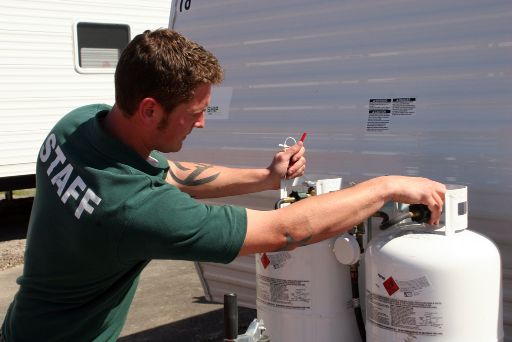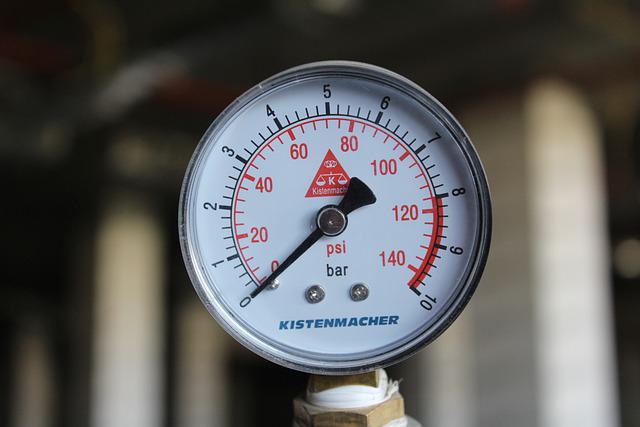
The debate about propane tanks and whether or not they can be next to houses is one that has been going on for years. Some people say that propane tanks are perfectly safe and can be next to houses, while others say that they are a danger and should be kept away from houses. So, what is the truth? Can propane tanks be next to houses?
[table id=3 /]
Recommended Distances and Placement
A. Safe distances from the house and property lines
When placing a propane tank near a house, the NFPA 58 and local regulations provide specific distances that need to be maintained to ensure safety. Typically, these guidelines stipulate that:
- Tanks up to 500 gallons should be placed a minimum of 10 feet from the house.
- Tanks between 501 – 2,000 gallons need to be at least 25 feet away.
- Larger tanks over 2,000 gallons often require a distance of 50 feet or more.
Additionally, propane tanks should be at least 10 feet from the property line, ensuring a buffer zone from neighbors. It’s also important to consider the placement of the tank in relation to other structures, such as sheds or garages, and public spaces like sidewalks or roads.
B. Considerations for tank size and capacity
The size and capacity of the propane tank are pivotal in determining the correct placement. Larger tanks, due to the increased volume of gas, pose a greater potential hazard and thus require more distance as a safety buffer. The capacity also determines how frequently the tank will need to be refilled; hence, ease of access for delivery trucks is an essential consideration. Tanks must be easily accessible for maintenance and filling without compromising safety.
C. Placement recommendations for above-ground vs. underground tanks
The placement of a propane tank also depends on whether it is above-ground or underground:
- Above-Ground Tanks: These tanks are more common and have different size regulations for placement. They need to be on a flat surface and away from the main traffic areas to avoid being hit by vehicles. They should be visible to avoid accidental damage during landscaping and other outdoor activities.
- Underground Tanks: While they have similar distance regulations to above-ground tanks, underground tanks have the added benefit of being less obtrusive and are sometimes subject to different aesthetic considerations. When installing an underground tank, it must be ensured that it’s not in an area prone to flooding, and soil conditions should be evaluated to prevent corrosion or shifting.
In all cases, regardless of tank type or size, it’s crucial to have a clear understanding of local codes, as they can impose additional requirements beyond national guidelines. The placement must also take into account the need for regular inspections and potential future removal or replacement, ensuring that the tank remains accessible for such activities. Always consult with a professional installer to ensure compliance with all safety regulations and standards.
Regulations and Codes for Propane Tank Placement
A. National Fire Protection Association (NFPA) guidelines
The NFPA sets forth a series of guidelines for the storage and handling of propane, officially documented in NFPA 58, the “Liquefied Petroleum Gas Code.” According to these guidelines, the placement of propane tanks relative to buildings must take into account several factors, including the tank’s capacity and the property’s size. For instance, smaller tanks of 125-500 gallons capacity must be at least 10 feet from a window or door opening, while larger tanks over 500 gallons have more stringent distance requirements. The NFPA guidelines also specify how close a propane tank can be to a property line or an appliance ignition source. Compliance with NFPA 58 is designed to minimize the risk of fire or explosion associated with propane tank leaks or failures.
B. Local building codes and regulations
While the NFPA provides the national standard, local building codes and regulations can vary significantly from one jurisdiction to another. Homeowners and builders must consult local codes for specific requirements on the placement of propane tanks, which might be more restrictive based on regional risks like wildfire zones or high-density residential areas. Local codes often reference the NFPA standards but might impose additional conditions, such as setbacks from neighboring buildings, requirements for protective barriers, or additional safety features like excess flow valves.
C. Importance of compliance with safety standards
Adhering to NFPA guidelines and local building codes is not merely a bureaucratic requirement; it’s a critical component of home safety. Compliance ensures that propane tanks are installed in a manner that considers the potential for property damage or personal injury should a leak or other hazardous situation arise. By following these standards, property owners can reduce the risk of incidents that could lead to significant harm to occupants, responders, and the public. Moreover, insurance policies and legal responsibilities are predicated on adherence to these standards, so non-compliance can lead to denied claims, fines, or worse in the event of an accident. It is essential for homeowners to recognize that these regulations have been developed through years of experience and are designed to protect lives and property.
Factors Affecting Propane Tank Placement
A. Potential ignition sources and their risks
Propane is a highly flammable fuel, and its storage must be carefully considered to prevent accidents. Ignition sources such as outdoor grills, fire pits, electrical equipment, and air conditioning units need to be located a safe distance from propane tanks to minimize the risk of ignition. The NFPA 58 guidelines specify that sources of ignition should be at least 10 feet away from propane tanks, but this distance may vary depending on local codes and the size of the tank. It’s important to avoid placing propane tanks near anything that could cause the propane to ignite, including vehicle traffic areas where a collision might pose a risk of tank damage and subsequent gas release.
B. Ventilation considerations
Propane tanks must be placed in well-ventilated areas to prevent the accumulation of gas in the event of a leak. For above-ground tanks, this generally means an open space free from overhangs or enclosures that could trap propane gas, which is heavier than air and tends to pool at ground level. For underground tanks, proper ventilation must also be ensured to prevent gas from seeping into enclosed spaces such as basements or crawl spaces. Adequate ventilation is essential for dispersing gas safely into the atmosphere and reducing the risk of asphyxiation or explosion.
C. Environmental factors (e.g., flooding, earthquakes)
Environmental conditions play a critical role in determining safe propane tank placement:
- Flooding: Tanks, whether above or underground, should not be placed in flood-prone areas where water can lead to floating or dislodgement. Elevated platforms or secure anchoring may be required in areas with a high risk of flooding.
- Earthquakes: In earthquake-prone regions, tanks need to be anchored securely to prevent tipping or shifting. Additionally, flexible connectors might be required to prevent gas lines from breaking.
- Wind Exposure: High wind areas may require tanks to be anchored to prevent tipping over, and shields or barriers might be necessary to protect the tank from flying debris during severe weather events.
- Temperature Extremes: Propane tanks should be placed in locations where they will not be subject to extreme heat or cold, which could affect the pressure and integrity of the tank.
- Terrain: The stability of the ground is crucial, especially for heavy propane tanks. Tanks should not be placed on unstable or shifting soils without proper foundational support.
While distance from ignition sources, adequate ventilation, and consideration of environmental factors are key to safe propane tank placement, it’s always vital to consult with local authorities and professionals to ensure that all local codes and environmental conditions are taken into account for the safe installation and operation of propane tanks.
Read related article: What Size Propane Line from Tank to House? (Why It Is Important)
Mitigating Risks with Proximity to the House
A. Protective measures and barriers
To mitigate risks when propane tanks are placed close to a house, certain protective measures and barriers can be implemented:
- Bollards and Barriers: Installing concrete or steel bollards around the tank can protect it from vehicle impacts. Fencing can also serve as a barrier to unauthorized access while still allowing for ventilation.
- Clearance: Maintaining a clear area around the propane tank free from flammable materials, such as leaves, debris, or other combustible materials, reduces the risk of a fire escalating if a leak occurs.
- Non-flammable Ground Cover: Using gravel or concrete as a base for the tank area instead of grass or other vegetation can help prevent fires.
- Protective Coatings: Regular maintenance might include the application of protective coatings to prevent rust or corrosion that could weaken the tank.
B. Emergency preparedness for leaks or other issues
Preparedness is key to effectively managing propane leaks or other issues:
- Emergency Plan: Homeowners should have an emergency plan that includes procedures for evacuation, turning off the propane supply, and contacting emergency services.
- Regular Inspections: Scheduling regular inspections by qualified professionals can help identify and fix potential issues before they become emergencies.
- Leak Detection: Know how to detect a propane leak (rotten egg smell) and educate all household members on the proper steps to take if a leak is suspected, such as not operating electrical switches or appliances, that could ignite the gas.
C. Importance of detectors and alarms
Detectors and alarms are crucial for the early detection of propane leaks and for ensuring the safety of residents:
- Propane Detectors: Install propane gas detectors at floor level, as propane is heavier than air and will pool at the ground if there is a leak.
- Carbon Monoxide Detectors: Since propane appliances can produce carbon monoxide (CO), having functioning CO detectors in the home can be a lifesaver.
- Regular Testing: Test detectors regularly and change batteries as needed to ensure they are operational at all times.
- Awareness: Ensure that all household members recognize the sound of the detectors and alarms and know the immediate actions to take upon detection of propane or CO.
Read related article: Selling House With Leased Propane Tank (Things to Consider)
FAQs
Are propane tanks safe next to the house?
- Yes, propane tanks can be safe next to a house when proper guidelines for installation distances, protective measures, and regular maintenance are observed. National and local fire codes, typically based on NFPA standards, must be adhered to.
Can a 100-gallon propane tank be next to the house?
- A 100-gallon propane tank generally needs to be installed at least 10 feet away from a building, including a house. This distance can vary based on local regulations, so it’s important to check with local fire codes and a licensed propane installer.
Do propane tanks need to be on concrete?
- Propane tanks do not necessarily need to be placed on concrete; however, they must be on a non-flammable, solid, and level surface to reduce the risk of fire and ensure stability. Options can include concrete pads, pavers, or sturdy stands designed for propane tanks. Consult with your propane supplier about the best foundation for your tank.
Where is the best place to put a propane tank?
- The best place to install a propane tank is determined by considering several factors, including:
- Local building and fire code requirements for safe distances from buildings, property lines, and ignition sources.
- Accessibility for delivery trucks and refill operations.
- Environmental considerations to avoid flood zones, high wind exposure, or areas susceptible to natural disasters like earthquakes.
- Ventilation to prevent gas accumulation in the event of a leak.
- The location allows for regular inspection and maintenance access.
Is it safe to keep a propane tank outside?
- Yes, it is safe to keep a propane tank outside; in fact, it’s the standard practice. Outdoor storage keeps the tank in a well-ventilated area and minimizes the risk of indoor gas accumulation. Tanks are designed to withstand normal outdoor temperature variations and weather conditions.
Read related article: How Long Will 250-Gallon Propane Tank Run a House Generator?
To Make a Conclusion
While proximity to the house can increase the risks associated with propane storage, these risks can be effectively managed and mitigated through thoughtful placement, robust protective measures, emergency preparedness, and the installation and maintenance of appropriate detectors and alarms. Always ensure compliance with local regulations and consult with propane suppliers and safety experts to keep your home safe.

Mike is an experienced propane technician with over 15 years of professional experience in the field. He has dedicated his career to helping customers with their propane needs, from installation to maintenance and repair. Together with Jeremy, he co-founded this website to provide useful information and guidance to customers seeking reliable propane services.




